| |
 |
 |
 |
 |
-GURU
|
 |
This is part two of our series on locks and keys.
- Lock Basics
- Wards and Bits
- Lever Tumblers
- Padlocks
Our recent Masterpiece Lock coverage in Volume 26 of the anvilfire NEWS
suggested this series on locks and keys.
Locks are relatively simple mechanical devices if you understand how they work.
Many years ago I took a course in Locksmithing that covered a great deal more than simple bolt locks in order to learn some of this.
As a result I am a Certified Locksmith albiet non-practicing.
Continued from Part I
|
 |
JOCK D
|
 |
Wards serve two purposes.
1) To make it difficult to pick the lock.
2) To alow only the key that fits the lock to operate.
Wards can be simple or complex obstructions to the key's operation.
In the high art warded keys of the Renaissance the wards were very complicated patterns.
|
 |
 |

Figure 1 |
The simplest ward is the plate ward.
These have a slot to allow entry of the key and a hole somewhat larger than the shank or barrel of the key.
|
 |
 |

Figure 2 |
This is a large brass key with a 3/4 x 1" bit with ward slots sawed into it.
|
 |
 |
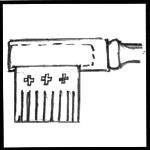
Figure 3 |
High art locks and keys had wards that made the key look like a comb there were so many ward slots.
In this key the little cross shaped holes are "false ward cuts" for decoration.
The key this photo was taken from had croses on alternating ward slots and then a row of false ward holes.
|
 |
 |
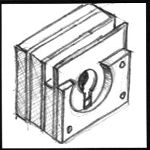
Figure 4 |
A lock with plate wards can be built by laminating thick and thin plates.
Ward plates are usualy fairly thin and can be cut from thin sheet metal or heavy shim stock of about 0.015 to 0.020".
Using a compass and scriber to make a fine layout these can be cut with a jewler's saw.
The spacer plates between the ward plates have simple round holes cut in them.
The plates are cut off where the bolt and tumbler operates.
|
 |
 |
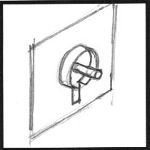
Figure 5 |
Circular (radial) or tube wards are fitted to the front or back plate of the lock.
|
 |
 |

Figure 15 |
My gate lock shown in Part I has two tubular wards.
One supported on the trapezoidal cross bar and the other welded to the inside of the front plate of the lock.
Note that when the gate is closed and locked there is a cover plate that protects the interior of this lock.
It was designed so that you could see its operation only when the gate was opened.
|
 |
 |
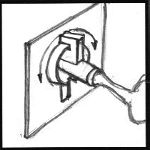
Figure 6 |
Ward cuts in the key in this case are from the front and back.
In finely made keys these cuts are curved in a radius to fit the ward when looking from the end of the key.
Othrwise they must be wide enough to fit around the curve of the ward.
|
 |
 |
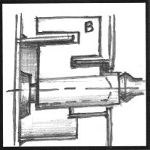
Figure 7 |
Slightly overlapping tubular wards give fair anti-picking protection as they make it difficult to access the bolt.
In my gate lock as in this drawing the bolt is operated at the location marked "B".
The lever tumbler is over top of the back tube.
This simple set of wards is seen repeated over and over.
Occasionaly a third ward is added making the bit of the key like a long snake.
|
 |
 |
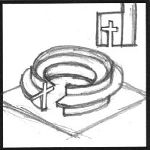
Figure 16 |
Another type of end plate ward that can be mounted on the front or back plate has a curved cross section as shown.
This type ward is made by casting, machining OR fabrication from thin plate.
Much of this type lock work is similar to making jewlery or instruments and a lot of silver soldered assemblies are used.
|
 |
 |

Figure 8 |
In high art locks the wards are assembled from thin plate silver soldered together in a ward case.
Very complex patterns were made.
Much of this work is more like that of a Jewler than other craftspeople.
Besides lots of silver soldering, many brass parts (including keys) are made by lost wax casting.
However, very fine work is also done in iron as can be seen in the ABANA Masterpiece lock.
|
 |
 |
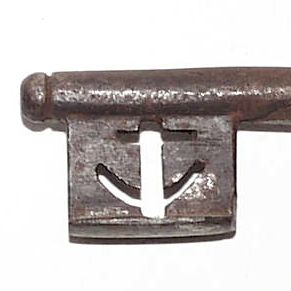
Figure 9 |
This is an old hand made iron key from my collection.
The anchor shaped ward without an external notch would seem impossible.
|
 |
 |

Figure 10 |
The ward for this type key is a casting or fabrication that is supported from one end.
This is a good candidate for a lost wax casting made from a lathe turned pattern.
|
 |
 |
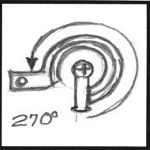
Figure 11 |
The limitation of this type lock and key is that the key cannot rotate 360° or be removed when the lock is unlocked.
This is common on certain types of locks such as jail locks that are never left unlocked OR spring action locks that do not need a key to move the bolt to lock.
|
 |
 |
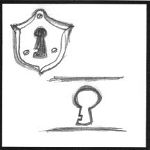
Figure 12 |
Keys with slots or protrusions have matching wards in the escutcheon plate, lock front plate and ward plates.
This is a common method of preventing different keys from entering otherwise identical locks.
This is an easy minor change to make when multiple locks are needed.
It is also easy to create a master key by having all the notches in one key.
|
 |
 |

Figure 1-16 |
Note that keys with protrusions are only prevented from fitting other locks but any key without the protrusion will fit similar locks.
This is a very low security system that is common on interior door locks.
The key to the left would fit any one of three locks with one or two tabs to fit the slots.
This would be a master key in a four key set. One without slots, one with a right slot, one with a left and the master key.
A lock with 2 tabs would only work with the master key so there could also be four locks.
|
 |
 |

Figure 13 |
The ABANA Masterpiece lock had a very intresting barrel key ward.
The key had a clover leaf outline and hole in the end that fit into and over a matching pin as shown.
|
 |
 |
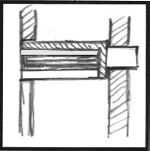
Figure 14 |
This part rotates in the back plate as well as being supported in the front.
This type arrangement clogs the keyhole more than a standard barrel key and lock making the lock difficult (but not impossible) to pick.
All warded locks only provide a modicum of security as all were pickable.
However, we no longer live in an age where these are common locks and it is unlikely that a theif would carry the large ungainly picks required for these locks today.
|
 |
JOCK D
|
 |
In Part III we will look into lever tumblers.
These are relatively difficult to pick and when combined with a system of wards make a fairly secure lock that you could sell with confidence.
The real security being the fact that these are custom locks.
Modern production locks give theives easy access to examples to practice picking and or to develop specialized picking tools.
Custom locks do not present this opportunity.
|
 |
JOCK D
|
 |
Questions? Comments.
|
 |
MKruzan
|
 |
Awesome!
|
 |
Pete F
|
 |
Great demo Jock! Does I gotta be crosseyed or just myopic to make locks?
|
 |
JOCK D
|
 |
Some of both. Your little 6" lathe is perfect for this stuff.
|
 |
Milt
|
 |
Guru --- very interesting, especially the anchor type key & lock mechanism.
Thanks for the program ---- again.
|
 |
PF
|
 |
then the wards would be turned rather than fabricated?
|
 |
JOCK D
|
 |
The one like in Figure 16 could be turned, and then the key slot sawed. The ward can have the back as part and screwed together OR silver soldered to the back plate.
Plate wards can have the hole machined. Bolt the stack together, machine the small ward hole through the stack, then remove the ward plates and machine the clearance holes in the spacer plates. Then everything is concentric when you reassemble.
|
 |
Shawn
|
 |
Considering all the slots, holes, etc on the wards, how thick are the bits on the keys?
|
 |
JOCK D
|
 |
Shawn, These type keys are relatively heavy, however modern bit keys with much of this are as thin as 1/8" and about 1/2" square. But the very fancy keys often have bits that are an inch square or more and as thick as 3/8" or more at the bottom. The thickest where they attach to the shank or barrel is usualy about 1/4".
|
 |
PF
|
 |
so, to pick the lock, the thief has to weave his way around all the wards and then push more than one release at once? Or is that next week?
|
 |
Shawn
|
 |
Thanks. That gives me an idea. I have to make a key for a door lock at a museum. They lost the only key that they had. Plus the missus, after seeing your first installment has decided that I can make her locks for her cabinets, storage boxes, soapmaking boxes, etc. This is really great info. I have been trying for years to find info with little success.
|
 |
JOCK D
|
 |
Yes. On the classic wared lock the theif had to put tension on the bolt, then lift the locking tumbler (I left that out in Part I). As soon as the locking tumbler is lifted the bolt moves and there is no need to keep lifting the locking tumbler.
On lever tumbler locks you have to lift multiple plates exactly the right height before the bolt will move. This increases the picking difficulty tremondously.
|
 |
PF
|
 |
Great!...thank you Good Guru!
|
 |
JOCK D
|
 |
Shawn, On old warded locks you take a key blank, soot it and try it in the lock.
Anywhere that the soot is scratched or marked you file away.
You can also do this on soft brass or zinc keys by looking at rub marks.
It takes good eyes (I probably can't do it any more) and an idea of what the inside of the lock looks like but you would be surprised how fast you can fit a key by trial and error.
Once the lock is open you can usualy remove it and make a better cleaner fitting key.
You can get blanks for many size bit keys from any large urban locksmith shop.
|
 |
|
 |
Links
|
 |